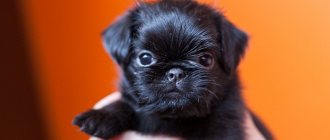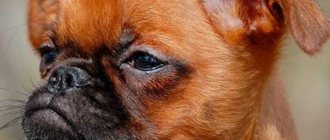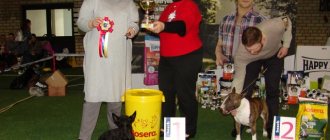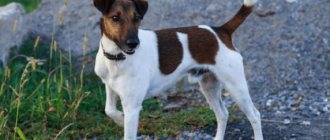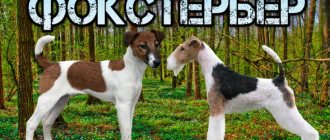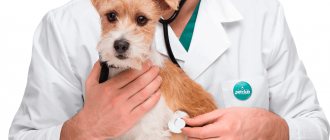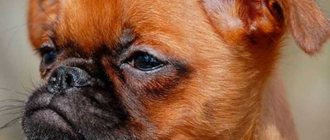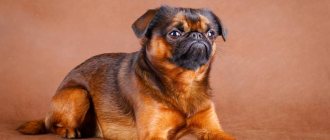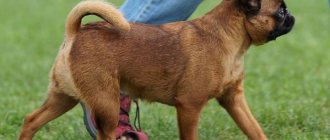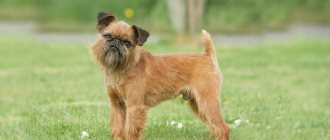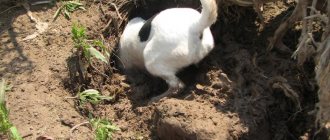Petit Brabançon care and maintenance
Caring for a Petit Brabançon is not difficult, but it is required.
The breed is short-haired and sheds. Shedding seasonal spring-autumn. Bitches shed more abundantly than males, especially after estrus or pregnancy. Brush the coat 1-2 times a week with a natural bristle brush. Do not neglect this procedure, as you remove dead hairs and dust, the dog receives an excellent massage that improves blood circulation.
During the molting period, the fur will have to be combed daily with a rubber comb, and during bathing, use a rubber glove to speed up the loss of dead hair. Choose a rubber comb that is small, soft and flexible. It is convenient for them to comb their head and paws. The coat must be combed against its growth, with strong and frequent movements, as if pulling out the hairs. Afterwards, they comb according to the growth of the fur. Always keep your comb clean of fur, otherwise combing will be ineffective. Sticking hairs on the tail, elbows and testicles should be carefully trimmed with scissors.
Photo of a black Petit Brabançon puppy
Bathe as needed or once a month, with shampoo for wire-haired dogs, without emollient oils. After using this shampoo, the coat becomes thick, not soft. Before bathing, place a rubber mat on the bottom of the bathtub or basin to prevent your pet's paws from slipping. After bathing, wipe the coat with a towel and dry with a hairdryer. Make sure that the dog does not sit in a draft until it dries completely. Dry wool can be sprinkled with a special oil for hair care, then thoroughly combed and rubbed with a piece of suede or cotton to give it shine. It is recommended to take a walk 2 hours after swimming; in winter, it is recommended to take a bath after the last walk.
Examine your eyes every day. Small gray lumps in the corners of the eyes in the morning are acceptable; they can be easily removed with a soft, lint-free cloth (dry or soaked in chamomile infusion). It is better not to use cotton wool, since the villi irritate the mucous membrane of the eye.
Petit Brabançon belongs to a number of brachycephalic breeds with large bulging eyes, and is at risk because there is a possibility of eye injury even while walking on tall, hard grass, a twig or branch. Therefore, to prevent eye injuries, do not allow your dog to come into contact with cats on the street, get into fights with other dogs, and be sure to wear a leash in dangerous places.
Ears: healthy ears, pleasant pink color, without redness or rash. Inspect your ears 1-2 times a week to notice changes in time. Dust and wax can be removed with a damp cotton pad dipped in warm water.
Use cotton swabs with extreme caution so as not to injure your ears. Never let children clean your dog's ears themselves.
If you notice redness, excess wax, rashes, a strange coating reminiscent of dirt, the dog often shakes its head and rubs its ears on the floor, immediately contact a veterinarian and do not treat it yourself. Believe me, there are many reasons for concern: otitis media, ear mites, allergies, so it is better to trust a professional.
Brush your teeth 3-4 times a week with a special toothpaste for dogs using a brush of a suitable size or a finger attachment. Do not use the paste on people as dogs do not like a lot of foam in the mouth and a strong menthol taste. To prevent the appearance of tartar, let your pet chew solid food and pieces of tomatoes.
Trim the nails once a month using a nail clipper for small breeds, smooth the sharp ends with a nail file to avoid burrs.
After walking, wash your paws or wipe them with a damp towel. Inspect the paw pads for wounds and treat them with an antiseptic if necessary. To prevent cracks from appearing, include vegetable oil (sea buckthorn, olive, flaxseed and others) in your Petit Brabançon diet.
Possible diseases
The Brussels Griffon belongs to small breed dogs, so they are characterized by almost all common diseases. The most common diseases are:
- Narrowing of the nostrils.
- Retinal atrophy.
- The presence of additional eyelashes.
- Cataract.
- The eyeball may fall out of the socket.
- Difficulty and problems with childbirth. In almost all cases, you will need the help of a veterinarian and a caesarean section.
- Dropsy of the brain.
- Hip dysplasia.
- Various dislocations. The kneecap is especially often affected.
- Allergy.
Therefore, the owner must carefully monitor his pet
It is especially important to maintain a proper diet. If the griffin owner notices any abnormalities in the behavior or health of the dog, he should immediately consult a doctor
Maintenance and care
We continue to flatter the Petit Brabançons, because in addition to its positive characteristics, the breed is not picky in its care. Four-legged animals get along well in an apartment or a house, in a large family or with a “hermit owner.” These irresistible dogs always become everyone's favorites in walking areas; they play with pleasure with other dogs and very rarely get involved in conflicts.
Considering the short stature of the breed, it is worth taking care of high-quality prevention of blood-sucking parasites and being vigilant during the flowering period of grasses. Some fruiting herbs are not only allergenic, but also pose a danger in the form of splinters and cuts. If the splinter is not removed in a timely manner, the dog’s body begins to reject foreign protein (plant tissue, microorganisms), which provokes purulent inflammation. Thorns driven under the skin or into the ears not only cause pain, but can also lead to increased body temperature, full-blown sepsis (intoxication) and even death.
Naturally, high-quality feeding of Petit Brabançon is the first and main aspect of dog care. Even the best health can be undermined by table feeding, treats in the form of bones, baked goods or pasta. Given their small size and tendency to become overweight, breeders recommend feeding Petit Brabançons with dry food for small and active dogs. A natural diet is also acceptable, provided you take care of vitamin supplements and weigh your pet regularly.
Grooming does not cause any special problems; you just need to clean your pet’s “fur coat” with a soft massage brush. However, do not be too deluded, Petit Brabançons have short but very thick hair, which causes some inconvenience during molting. Bathing is carried out after seasonal molting and when soiled. Washing your dog too often can lead to dandruff, itching and discomfort for your pet. Clothing for Petit Brabançon eliminates heavy contamination in inclement weather and hypothermia in frosty weather. In winter, it is recommended to reduce walks, and in fact this is not entirely true. It’s best to consider a more dynamic walk and gradually harden your pet’s body.
The characteristics of the breed require careful care of the eyes and teeth. Given the propensity for ophthalmic diseases, your pet should be shown to the veterinarian at least once every six months. Overeating, despite tightly closed teeth, is a risk factor. Firstly, tightly standing incisors need to be cleaned of plaque (if necessary), especially if there is a curvature of the dentition. Secondly, you need to monitor the health of your chewing teeth, since if they are not fully closed, they deteriorate quite quickly. The first symptom is darkening of the enamel, the second is an unpleasant odor from the mouth. Ear care usually does not cause problems. It is enough to clean the ears once every 2-3 weeks. However, if you notice plaque that has an odor, color, or is itchy, contact your veterinarian without delay. According to the subjective opinion of successful owners, problems more often arise in dogs with uncropped ears.
Purpose
Since the recognition of the breed by the International Canine Organization FCI, griffins have been classified as small guard and companion dogs. Initially, Griffon dogs were bred to hunt barn and domestic rodents, mainly rats. Farmers took dogs with pleasure, since their hunting qualities significantly exceeded the dexterity and skills of cats.
Nowadays, the griffin is becoming a favorite of European drivers. The companion dog is officially recognized as a mascot by bus drivers in Brussels - the dog has proven itself so positively as a companion for road service employees.
Modern representatives of the breed have not lost the hunting qualities of their distant ancestors. Moreover, brave and energetic, with an active life position, positive in all respects, griffins are ready to protect their owner, his children and property until their last breath. The dog, however, will not bite the enemy, but will try to bite him strongly with his small sharp teeth.
Nutrition
Before feeding your Petit Brabançon new food, you should first consult with the breeder, especially for puppies, and then with your veterinarian. Until the age of six months, they try to feed the little Brabançon according to the nursery’s recommendations. An older dog is switched to an appropriate diet.
It is categorically not recommended to pamper a puppy, to compose a diet from those foods that he likes, and not from what dogs should be given in puppyhood. Quite quickly, such puppies grow into domestic tyrants, demanding satisfaction with goodies.
Small breeds prefer to be fed from the table. But it is strictly not recommended to do this with giffons. It is best to feed them with special super-premium food for small breeds and avoid harmful variety of food.
As you age, you should add vegetables to your main diet - pumpkin and zucchini, as well as fruits - apples and bananas. It is not recommended to give either grapes or sweet fruits and berries. You can replace one feeding per week with lean meat, liver or heart, after all, dogs are natural predators.
Meat can be alternated with sea fish, giving it once a month, not forgetting to arrange fasting days for gluttonous pets.
Kinds
The griffon breed includes three types of dogs:
- Belgian Griffon (wire-haired, black);
- Brussels Griffon (red fur, as hard as wire);
- Petit Brabançon (small Belgian dogs or smooth-haired griffins).
Key points in training
Even decorative dogs need to be trained. You need to start from birth. The puppy must understand who is boss in the house, what can and cannot be done. There are several rules to establish a hierarchy:
- Ban on playing on human furniture;
- Begging is prohibited; feeding takes place only after the family gets up from the table;
- A person enters the house first;
- Barking without reason is punished;
- The owner is always the authority.
A spoiled puppy will be difficult to re-educate at an older age. From 3 months, babies are trained in a targeted manner. They start with simple commands, remembering the name, daily routine. Kennel clubs recommend completing the “Dog in the City” program. It turns on all the necessary signals, they will help the pet navigate the city space and make walks safe.
By six months the dog should know its name and basic commands:
- "sit";
- "place";
- "near";
- "it is forbidden";
- "voice".
Pettit needs mental training. Therefore, after learning all the necessary words, they switch to visual signals or a whistle.
Health
Immunity against viral and colds is quite high, with adequate care and good living conditions.
Problems such as complications during childbirth, additional or altered eyelashes, dislocation of the eyeball, clouding of the crystalline lens, or retinal degeneration are common. An excessively elevated nose or narrowing of the nasal passages may occur.
When selling, Brussels Griffon puppies must be vaccinated according to all rules. In addition, they need to be examined by a specialist to exclude congenital and hereditary pathologies.
Recommended age for sale is 3 months.
Brabançon's appearance
The dog is very small, but has a strong build. The pet's character is cheerful, self-sufficient, sociable, vigilant, active, devoted. At the same time, the dog has no cowardice or tendency to aggression.
Some believe that within the breed there is a division into a small “bird” and a large one. This happens due to the fact that you can meet both strong dogs up to 4 kg and graceful dogs weighing 6 kg. However, all these animals belong to the same breed. The width of the bones, the height at the withers, the weight - all this depends only on the method of rearing and genetics.
Puppies inherit the body type of their father and mother, so before purchasing a puppy you should look at both parents to get an idea of the appearance of your future dog. If the litter is from an “imported” male, you should study its metrics and photographs. According to the breed standard, weight can range from 4 to 6 kg. The standard does not mention the height of the animal, but it is usually 18-32 cm at the withers.
Petit Brabançon breed standard
There are special requirements for the psyche and temperament of animals for breeding:
Head. Breed feature – large, rounded skull
When assessing a dog, you need to pay attention to its facial expressions - the “face” should be mobile, reminiscent of a monkey. The forehead line is rounded, clearly extending into the front part
The muzzle is very short - no longer than 1.5 cm. The hair on the muzzle is short, the “upturned” dorsum of the nose is clearly visible. The lips are not thick, tightly fitting. The upper lip should not droop. The pigmentation of the lips is full, the color is rich black.
Teeth. The breed is characterized by an undershot, the lower jaw is upturned. The incisors are vertical, forming straight and parallel. The jaws close tightly, the teeth are hidden, the tongue is placed in the mouth. In profile you can see that the chin is longer than the nose. Dogs of the Petit Brabançon breed are characterized by an undershot bite, with the lower jaw upturned.
Nose: Rounded, with clearly separated nostrils. The back is upturned, the tip is pulled back. In profile, you can see that the tip of the nose and the top of the forehead are approximately at the same level. If the lobe is not at eye level, this is considered a defect.
Eyes: Wide set, round slit, large, but not protruding. The eyelids are well pigmented, dense, hiding the whites of the eyes. The color of the pupil is brown in various shades, rich. Slanted, small eyes or light irises are developmental defects.
Ears: Cropped, set wide apart, natural length. The shape of the ears is triangular, broken in the lower third, the tip is lowered towards the muzzle. Large ears or drooping ears to the side are considered an acceptable fault. When docked, the ears are pointed and erect.
Body: Square, height at withers approximately equal to length of back. The neck is medium length, voluminous. The sternum is developed, not wide. The ribs are not flat, they are pulled back, the front part is convex. The shoulder girdle is well developed, wide, the back line is even, the withers are clear, the croup is smoothly sloping. The groin is tucked, the “undermining” is well defined.
Limbs: Wide apart, well-developed muscles. The shoulders are wide, the elbows are pressed to the sternum, the wrists are straight. The hind legs are moved back in the stance, the thigh is not long. The fingers are gathered tightly, bent, the hands are rounded. Finger fusion is undesirable, although acceptable. The pads and claws are dense and dark.
Tail: Two-thirds docked or natural. The position is vertical. The tip is bent but not curled. Doesn't touch the croup.
Coat and color of Brabançons
Petit Brabançon is a short-haired breed. The hair is hard, thick, no longer than 2 cm. Shorter hair is on the face, ears and the front of the limbs. There is no “brush” on the eyebrows and muzzle.
The color of Petit Brabançon can be like this:
- black;
- deer;
- black and tan (with red, red or fawn tan);
- mix (a mixture of any specified colors).
Description
The Petit Brabançon (or Brabant Griffon, Miniature Brabançon, Shorthaired Griffon) is an ancient breed of tiny lap dogs with Belgian roots.
In the past it was used to catch rats and guard the carriages of the aristocracy. Today it is popular as an ornamental pet with a delightfully affectionate and sociable disposition.
Peculiarities
Compared to the Brussels and Belgian “brothers”, it does not have a typical beard, has smooth and shorter hair and a characteristic upturned face.
The charming muzzle was inherited from the “German” - a wire-haired Affepinscher, and the beautiful color from the Cavalier King Charles Spaniel.
Interesting fact
The level of intellectual abilities of this dog corresponds to the mental abilities of a three-year-old child.
Distinctive features
Head
The skull is rounded and spacious with a noticeably convex frontal part and a clearly defined stop. The head looks voluminous in relation to the body. The muzzles are upturned, flattened, no more than 1.5 cm long.
Teeth
The lower jaw is quite wide with a characteristic arch, overlapping the upper jaw. The teeth are in full set, placed in an even line and parallel to each other.
Ears
The ears are small, set high, and located far from each other. Natural ears are drooping, cropped ears have pointed tips and are fully erect.
Eyes
The eyes are round, large, without protrusion, located far from each other. The color of the iris ranges from brown to black.
Frame
The body is strong, muscular, square in shape, but looks elegant and graceful. The neck is muscular and of medium length. The sternum is wide, protrudes slightly forward and descends to the elbow joints. The ribs are slightly convex. The loin is of medium length, straight, strong, slightly arched, athletic. The croup is smooth, wide, moderately sloping. The stomach is slightly retracted.
Limbs
The legs are strong, parallel, set wide. The paws are round, compact in size with strong wrists and tightly closed toes. The pads are compacted and dark in color. The claws are strong, black pigmented.
Wool
The hair is quite short, no more than 2 cm in length, moderately coarse, shiny and thick. Color black, reddish, black and tan, fawn. There is always a dark mask on the face.
Interesting fact
Having reached a venerable age, the Brabant Griffon still remains playful, as in puppyhood.
Character
The Brabant Griffon is an amazingly charming and curious pet, strongly attached to the owner and to all family members. He is an absolute good-natured person and does not know how to take offense at all.
It is extremely important for a dog to be the center of attention. Although he has a balanced temperament, he has pride, therefore he listens and obeys only close people
Quite subtly senses the mood of the owner, like a real friend tries to adapt to him. It does not tolerate long-term separation well, so it is better to avoid such a situation and take it with you on a trip.
He gets along well with children and willingly participates in children's games. Never chases domestic animals of any kind, always finds a common language with cats and dogs of any size.
Despite its small size, it is brave and not at all shy. By nature, he is a very sociable creature, always happy to have guests, and at the same time, delicately and with a sense of tact, he will do everything to charm them.
Easily amenable to training and education, perfectly retains the acquired skills in memory.
Interesting fact
A dog's face, like a person's face, is capable of expressing various emotions. Joy, sadness or a melancholy mood can be easily read from the pet’s “face”.
How to care for a small Brabançon
Petit Brabançon gets along well in an apartment. This is due to its small dimensions. He responds well to training. So it won’t be difficult to train him to go to the litter box. But such a dog will not sit locked up for a long time. She needs to be walked.
The dog must splash out its energy. Therefore, during a walk, let her run around the area.
Caring for such a dog is not difficult at all. Just look at his appearance. The dog needs to be brushed weekly. It is advisable to bathe twice a month. Use special products for bathing. After taking a shower, be sure to dry your pet's fur. Otherwise, there is a risk that he will catch a cold.
Pay attention to your pet's teeth and eyes. Because they are prone to eye diseases
This is why you need to visit a veterinarian at least once every six months. Food is also a risk factor for teeth. They need to be cleaned. If the enamel on your pet’s teeth has darkened and there is an unpleasant odor coming from the mouth, then you need to consult a doctor for treatment.
Ears should be cleaned at least once a month. Make sure that deposits of unusual colors do not appear. If you notice spots, an odor, or that your dog is constantly itching, you should immediately visit a doctor.
Things will be much more difficult with food. The pet is a real picky person in this matter. You won't force him to eat something he doesn't like.
Buy special bowls on a bracket. They will rise as the pet grows. This way you will maintain correct posture for him.
When feeding, it is important to follow the following regimen:
- A puppy up to six months old needs to be fed 4-5 times a day.
- For a pet older than six months – 2–3 times a day.
You can feed your pet natural food and dry food. Here everything will depend on the owner. If you choose natural food, then your diet should include:
- Fruits and vegetables.
- Eggs and yoghurts.
- Fish and various cereals.
If you choose dry food, then you need to put a second bowl for water. Add vitamins to your food. And constantly monitor your weight by weighing your pet.
Invitation
The oldest dog breed is the Griffon.
We invite you to the dog show! RULES FOR REGISTRATION OF DOGS FOR THE SHOW PLEASE REQUEST! BEFORE REGISTERING YOUR DOG FOR THE SHOW, PLEASE READ THESE RULES IN DETAIL! Registration of dogs for participation in the exhibition is carried out upon provision of the following package of documents: - A completed application form for one dog, signed by the owner (or an application through the zooportal.pro system) - a copy of the dog's pedigree or a copy of the puppy's metrics (only for baby, puppy, junior classes) . — a copy of the receipt for payment of the participant’s voluntary target contribution — copies of international work certificates and champion certificates when registering for the working class and the champion class
Attention! Without providing the above certificates, registration for the exhibition will be in the open class. Registration for International Exhibitions in classes in which CACIB is awarded - intermediate, open, working, champions, must be carried out only on the export pedigree "EXPORT PEDIGREE" or on the pedigree in one of the FCI languages "PEDIGREE"
The applicant is responsible for the correctness of the information provided about the dog. Corrections and additions to the application form are not allowed. Transferring a dog from class to class is not allowed. Attention! When registering a dog for an exhibition: - all scans of documents must be sent only in JPG or PDF format; — when registering two or more dogs, all documents must be sent for each dog in a separate letter (each separate application through the zooportal.pro system); — registration of a dog is carried out only upon receipt of a complete package of scanned documents with a scanned copy of the receipt for payment of the voluntary target fee attached in compliance with the deadlines for its payment (No later than the last day of the established period); — please indicate valid contact numbers in the application form! If the owners of the dogs do not provide the specified documents, or if the documents are provided in violation of the established deadlines, the dogs will not be registered for participation in the exhibition. To correctly enter information about a dog into the Exhibition Catalogue, when filling out a receipt or payment order for payment of a voluntary target contribution for the organization and holding of an exhibition, you must indicate: - the name of the exhibition; - breed of dog; - the dog's name; - Class; - Full name of the dog owner. Please attach receipts for payment of the fee to your application. ATTENTION! The target fee is not returned to the dog owner (except for the death of the dog, confirmed by a certificate issued by the state veterinary clinic, if the certificate is provided to the exhibition organizing committee before the end of registration). Each participant must have a VETERINARY PASSPORT with marks from the state veterinary clinic on vaccination against rabies. When receiving accompanying documents F-1 and F-4 for participation in a dog show, you may need to name the site in the Mercury system, the enterprise number in the registry and the enterprise number in the Cerberus IS - check the requirements with the organizer. If there are no veterinary documents, the veterinary control officer has every right not to allow your dog to participate in the exhibition. show more
Character traits
Overall, these dogs can be excellent companions for people of all ages. They subtly sense the mood of their owners and can become favorites in large families.
They love to play and highly value human attention, trying to respond with gratitude and good behavior. Despite the fact that they are not timid, these dogs are by no means angry and do not harbor resentment if the owner behaves unfairly towards them
Pets are very smart, have a sense of self-esteem and can show a lot of emotions, which is liked not only by their breeders, but also by those around them. Sometimes the dog seems thoughtful, sometimes sad, sometimes funny or even beaming with happiness. They show a very active range of emotions, accompanying their thoughts with actions.
They do not cause much trouble when travelling, they are easy-going and adapt to any requirements of breeders. However, homes without owners are very sad. The fact that they are left with people they know well does not help the situation. These dogs show true loyalty and devotion to their owners.
For animals, being part of a family is extremely important, and therefore no one and nothing can replace their family, without which they consider themselves abandoned and useless to anyone.
When the owner is nearby, the dog is incredibly happy, he is obedient and enjoys every minute given to him by the person. However, at heart, a dog that loves to show tenderness towards members of the household considers itself independent and has a proud character. Living with a person for a long time, she is able not only to learn to adapt to his mood and emotional state. This little dog can adopt the facial expressions of its favorite breeder, becoming a reflection of its owner.
Despite the need for communication, the Brabançon will not allow himself to be excessively intrusive; he will not get in the way of his owners. Even as a puppy, he will try to behave well, please the person so that the owner will love him. At the same time, the dog does not lose its protective qualities; if necessary, it will show its fearlessness, despite its funny appearance. In relation to other pets, she will also not be intrusive, but if desired, she will always support any game or undertaking.
Unlike his other brothers, the Brabançon understands his master's jokes and does not respond to them with anger. He does not lose his playfulness and positive attitude throughout his life, and he shows playfulness not only with the adults in the household, he also loves children. Even at an old age, he will not deny himself the pleasure of playing with them; everyone loves the animal’s tirelessness, it is worthy of admiration.
When necessary, an animal can empathize with its owner. However, if an inexperienced owner believes that the baby is just as friendly to others, then this is not at all the case. For a Brabançon, strangers do not have the same value as members of the family in which he lives. It is only the owners who think that the dog is good-natured: practice proves that these dogs are often very wary of strangers.
They don’t like others at all, which they express with appropriate emotions and behavior. It’s not difficult to predict him: just look at the expression of his muzzle. As for domestic animals, the only species in which pets show genuine hunting interest are small rodents. They don't bother cats, rabbits or birds, but they can chase rats and hamsters.
What it is?
Lesser Basset Griffon Vendean
Griffon is the general name for several dog breeds with similar external characteristics and qualities. The most famous varieties of Griffons are the Belgian, Brussels and Petit Brabançon. This dog breed is considered one of the oldest in the world.
No one knows exactly which breeds became the first ancestors of griffons - most likely, over these 500 years, at least a dozen different breeds with different external characteristics and qualities took part in the selection. The closest relatives of modern dog breeds to Griffons are the Affenpinscher, Toy Terrier and Pekingese. These dogs are similar in appearance, but differ in different character traits. In addition, it recently became known that Affenpinschers appeared much later than Griffons.
At the moment, griffons are most often found in France, as well as in America and Germany. The reason for the popularization of the breed among the population was the cute appearance of the individual, as well as the fashion for small dogs, which began at the beginning of the 14th century. If at the very beginning these dogs could only be bought by wealthy people who took them to high receptions and balls, then over time griffons became excellent companions for the common population. For example, they served on farms, helped herd livestock, caught rodents, and drove predatory animals and birds away from livestock.
Since then, griffons began to actively spread throughout the world - in some places they assimilated with local breeds and lost their individuality, and in others they acquired new features. So, for example, some crossed breeds of griffons are wonderful hunting dogs (for example, the Korthals griffon).
Belgium is considered the birthplace of griffons - it was here that the first specimens of the breed were introduced at the end of the 19th century, and the first griffon standard was adopted. The griffon breed was finally able to form only by 1928, however, individuals of this breed were brought to Russia and the CIS only towards the end of the twentieth century - along with some other breeds from the USA. Around the same time, the International Griffon Club was formed and opened, which continues to operate to this day.
There are many funny and sad stories associated with griffons. For example, the Serbian Queen Draga had the habit of feeding elements of her food first to her pets, and then starting dinner on her own. It so happened that the queen’s favorite was the griffon, and at one of the dinners the food actually turned out to be poisoned. As a result, the queen’s health was not in danger, but her pet could not be saved.
Petit Brabançon pros
Of course, examining and “disassembling” such a living creature as a dog into its pros and cons, on the one hand, is a thankless task.
But, on the other hand, it is an urgent need for such a decisive step as purchasing a Brabançon puppy to be balanced and conscious. This breed is, so to speak, universal. Dogs will become true and faithful friends both for lonely people and everyone’s favorites in a large family. They are very faithful and devoted, and experience separation quite hard. Therefore, especially during the holiday season, it is recommended to consider spending time together with your pet.
In addition, animals of this breed are extremely cheerful and love to play pranks and have fun. They will easily find a common language with both the baby and other pets. They get along well with other dogs and cats and can live with them under the same roof without any problems. But not with rats, hamsters and other rodents!
Another advantage that deserves attention is their sensuality and insight. They understand and catch the owner’s mood without further ado. When your soul is cheerful and joyful, they will support this wave of positive emotions. If this happens, and you are preoccupied or upset about something, the dog will instantly pick up on your mood and will look at you with an emotion unusual for other breeds. You may not even believe it, but this is perhaps the only breed that can sit and cry with you. Yes, yes, exactly cry. Often emotions overwhelm a dog’s heart, and you can really see how your pet is very worried and suffers with you. By the way, as for the eyes and facial expressions in general, this breed is quite diverse. You won’t have to guess what your pet “likes” or, conversely, what he doesn’t like. Just look into these huge, intelligent eyes and you will immediately understand everything.
Also, it is worth paying tribute to the intelligence of this breed. It is not for nothing that many scientists compare the intelligence of this dog with the intelligence of a three-year-old child. And indeed it is. Most breeds are unable to distinguish between your words and understand their meaning. Dogs are guided solely by the way information is presented and its intonation. You can check it yourself. Praise said loudly and strictly: “well done,” will make the dog press its tail with a guilty look. Exactly the opposite is the case with words of indignation, which will be spoken in a soft and affectionate form. But such tricks will not work with the Brabant Griffon. Thanks to numerous experiments, it has been proven that Brabançons not only pick up intonation, but also distinguish the meaning of words. That is why getting along with and raising this dog will be very easy and simple.
Often the scales of choice tip in favor of those dogs that are easy and simple to care for. Of course, there are people who are ready to bathe and scratch their pet almost every day. But, as practice shows, after a couple of months, this fervor fades away, and willy-nilly they begin to envy those owners whose dogs are easy to care for. The Petit Brabançon is rightfully considered to be such a dog. Due to its short, but fairly stiff coat, grooming is kept to a minimum. It is enough to bathe your dog once a month (or better yet, do it as needed) and monitor the condition of the ears, teeth and claws. Despite the coat, which is very short, it is still necessary to comb it to get rid of excess dead hair. It is not necessary to do this every day, but at least once a week you can take a good walk with the Furminator.
In addition to all the above advantages, it is worth noting the unpretentiousness and ability of animals to adapt to everything that surrounds it. After a month or two, you won’t even notice how your pet will begin to imitate you in literally everything. And some owners claim that their pets have adopted not only their habits, but even their gait!
History of the origin of the breed
There are three varieties - Brussels, Belgian and Wirehaired, or Psi-Brabançon, all of which belong to the same breed of Griffon. According to one version of the origin of the breed, they owe their appearance at the end of the 17th century to the small Belgian wirehaired Smousje.
It was a fairly common street dog from the area around Brussels, with blood mixed in from a German Affenpinscher, a Ruby Spaniel and a Pug.
Already in the 18th century, small terriers took an active part in further breeding. Therefore, the ancestors of the modern griffin are somewhat different in their elongated muzzle, evil disposition and increased size.
In order to reduce growth, form a certain type and consolidate its hunting qualities (since the dog was bred purposefully: to catch rats and other rodents), they began to use the English Toy Spaniel for breeding.
In 1800, the griffin dog breed was introduced to the International Canine Commonwealth. Popularity in Europe grew as dogs became more common. It was at this time that Yorkshire terriers were attracted to breeding as partners with hunting skills. The resulting type was consolidated by the Smoushond and Barbet breeds, as well as the Pekingese - a dog, according to many, that cannot bark.
